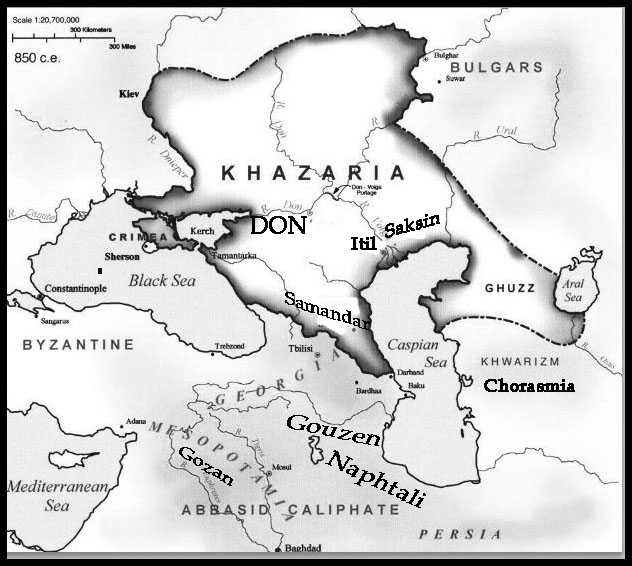Answers to Quora Questions by Yair Davidiy
Did anyone recently attempt to locate the river Sambatyon & the lost ten Jewish tribes?
https://www.quora.com/Did-anyone-recently-attempt-to-locate-the-river-Sambatyon-the-lost-ten-Jewish-tribes/answer/Yair-Davidiy

Map drawn by Estelle Schutte on behalf of Brit-Am.
The northern Ten Tribes were exiled by the Assyrians and lost consciousness of their ancestry. One of the places they initially went to was known as the Sambation.
The name Sambation appears to have been applied to several rivers in the Middle East and southern Russia. These include the Khabur River in northern Syria, the Little Zab in western Iran, and the Ouzen in Azwerbaijan, and also the Don and Dneiper River in southern Russia. The name accompanied Israelite Exiles as they migrated northwards. They became part of the Cimmerian, Scythian, and Gothic federations and moved with them to Western Europe.
In summary:
The Talmud and Midrashim say the Lost Ten Tribes were taken or moved to three different regions. One of the regions was the Sambation and another area (in some versions) was denoted as "Beyond the Sambation".
The name "Sambat" in Jewish-Greek dialects and in other tongues can connote "Sabbath". The terms Sambat, and Sabbath or names meaning Sabbath are interchange in the sources. A Jewish legend says that the Sambation flows for six days and stops on the seventh. Another legend says that Instead of gushing with water the Sambation throws up stones.
There may be symbolic significance in these myths. Nevertheless, there is an historical basis for the Talmud locating the Lost Ten Tribes by the Sambation.
Nachmanides (1194-1270) identified the Sambation with the River Gozen. The Bible mentions the River Gozan as one of the places of exile (2-Kings 17:6, 1-Chronicles 6:26).
The River Gozen is often identified the Khabor River in North Central Syria which is located in an area that was called "Gozan" in Biblical Times. Assyrian inscriptions mention Exiles from Israel in this region.
To the east of the Gozan region and south west of the Caspian Sea is the Ouzen River (Quizel Uzen) which locally is also pronounced something like "Gozen." The Talmud (Yebamot 17) appears to identify this as the Gozan River of the Exiles. Israelite exiles were also in this region as mentioned in the Apocryphic Book of Tobias. This is the region of Azerbaijan which was also an early Scythian center. To the southeast of the Ouzen River are the Great Zab and the Little Zab Rivers that flow into the Tigris River. To the west of the Little Zab Ptolemy placed the Sambatae people. The Little Zab in Greek writings is referred to as Sabatus and according to Zevi Kasdoi (1928) was locally also known as the Sabat. These combinations Ouzen-Gozen, Sambatae-Sambation, Sambation-Sabatus-Sabat-Sabbath all indicate that the Sambation was in that region and we know from other sources that Israel exiles were in all these areas. These were also the regions in which the Cimmerians, Scythians, and Goths first appeared. We identify these peoples as, at least in part, Israelites. From these regions the Scythians and Guti (Goths) moved northwards and established a center in the Steppes of Southern Russia where the Dneister, Don and Dneiper River regions come together. Just as the Israelite-Scythians moved to Southern Russia so too did the concept of the '"Sambation River" move with them. The Dneiper River was recorded by Arab writers as the River of Shabat. Kiev on the Dneiper River had been founded by a Scythian people related to the Khazars and was known as Sambat which is similar to Sambation.
In addition the personal name "Sambation" has been recorded on Greek-Language inscriptions from the Scythian city of Tanais at the mouth of the Don River. Eldad HaDani (ca. 850 CE) and other early Jewish traditions also identified the Sambation with the River Don.
It has been shown that among the people of Tanais, on the Don River, were Scythian Israelites who revered their forefather Joseph.
See:
"The Syncretic Creed of Hellenized Jews from Tanais (Black Sea Region)", Proceedings of the Eleventh World Congress of Jewish Studies, Division B, Volume 1: Second Temple Period to Modern Times, World Union of Jewish Studies, Jerusalem, Israel, 1994.
See Also:
Abraham Polack ("Chuzaria," Hebrew, 1949) and also articles in the Encyclopedia Judaica and the Jewish Encyclopedia on the Khazars. This was the region of the Scythians and the legends in question refer to the Scythian period.
From this region came the Anglo-Saxons and some of the other settlers of Western Europe.
